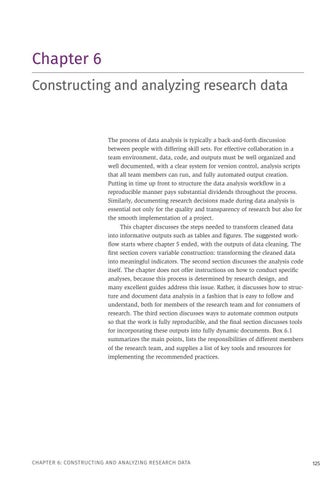Chapter 6 Constructing and analyzing research data
The process of data analysis is typically a back-and-forth discussion between people with differing skill sets. For effective collaboration in a team environment, data, code, and outputs must be well organized and well documented, with a clear system for version control, analysis scripts that all team members can run, and fully automated output creation. Putting in time up front to structure the data analysis workflow in a reproducible manner pays substantial dividends throughout the process. Similarly, documenting research decisions made during data analysis is essential not only for the quality and transparency of research but also for the smooth implementation of a project. This chapter discusses the steps needed to transform cleaned data into informative outputs such as tables and figures. The suggested workflow starts where chapter 5 ended, with the outputs of data cleaning. The first section covers variable construction: transforming the cleaned data into meaningful indicators. The second section discusses the analysis code itself. The chapter does not offer instructions on how to conduct specific analyses, because this process is determined by research design, and many excellent guides address this issue. Rather, it discusses how to structure and document data analysis in a fashion that is easy to follow and understand, both for members of the research team and for consumers of research. The third section discusses ways to automate common outputs so that the work is fully reproducible, and the final section discusses tools for incorporating these outputs into fully dynamic documents. Box 6.1 summarizes the main points, lists the responsibilities of different members of the research team, and supplies a list of key tools and resources for implementing the recommended practices.
CHAPTER 6: CONSTRUCTING AND ANALYZING RESEARCH DATA
125





